What is the usage of distinct in oracle?
Oracle's distinct usage can filter duplicate rows in the result set to ensure that the value of the specified column or columns returned in the "SELECT" clause is unique. The syntax is "SELECT DISTINCT column 1, column 2, column 3... from table name". "distinct" will sort the returned result set and can be used in conjunction with "order by" to improve efficiency.

#The operating environment of this article: Windows 10 system, Oracle version 19c, DELL G3 computer.
Oracle Distinct Usage
SELECT DISTINCT can be used to filter duplicate rows in the result set to ensure that the value of one or more columns specified in the SELECT clause is unique. .
Only use it to return the number of non-duplicate records, rather than use it to return all values of non-duplicate records. The reason is that distinct can only be solved by double loop query, which will undoubtedly directly affect the efficiency of a website with a very large amount of data.
distinct will sort the returned result set, so it is best to use it in conjunction with order by to improve efficiency.
Oracle SELECT DISTINCT usage
The syntax of the SELECT DISTINCT statement is as follows:
SELECT DISTINCT
column_1
FROM
table_name;In the above syntax, the value in the column_1 column of the table_name table will Compare to filter duplicates.
To retrieve unique data based on multiple columns, just specify the list of columns in the SELECT clause as follows:
SELECT DISTINCT column_1,
column_2,
...
FROM
table_name;In this syntax, the values in column_1, column_2 and column_n The combination is used to determine the uniqueness of the data.
The DISTINCT clause can only be used in a SELECT statement.
Please note that there is no difference between DISTINCT and UNIQUE in Oracle. They are synonyms. DISTINCT follows the ANSI standard, and UNIQUE is Oracle-specific. From a transplant perspective, it is better to use DISTINCT that follows the ANSI standard. s Choice.
Oracle DISTINCT Example
Let’s take a look at some examples of how to use SELECT DISTINCT to see how it works.
1. A simple example of Oracle DISTINCT
The following is a table
字段1 字段2 id name 1 a 2 b 3 c 4 c 5 b
If you want to use one statement to query all data with non-duplicate names, you must use distinct Remove redundant duplicate records. So first enter:
select *, count(distinct name) from table group by name
Then we enter:
id name count(distinct name)
and get the result:
1 a 1 2 b 1 3 c 1
2. Examples of Oracle DISTINCT applied on a column
are as follows Example to retrieve the names of all contacts:
SELECT first_name FROM contacts ORDER BY first_name;
Execute the above query statement and get the following results:
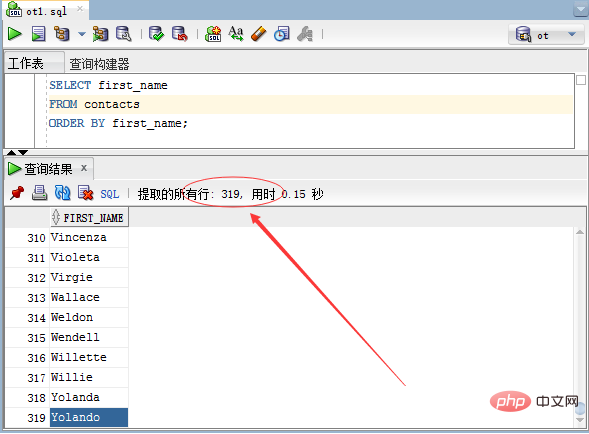
The query returned 319 rows, indicating that the contact ( contacts) table has 319 rows.
To get unique contact names, you can add the DISTINCT keyword to the SELECT statement above, as shown below:
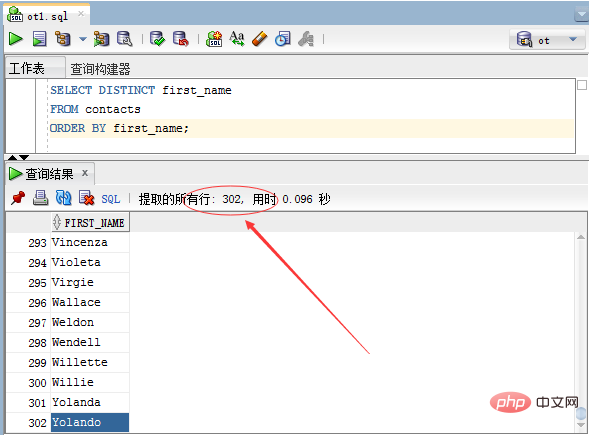
The query returned Row 302 means that 17 rows in the contacts table are duplicates and they have been filtered.
2. Oracle DISTINCT application multi-column example
Look at the order_items table below. The structure of the table is as follows:
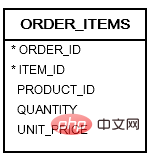
The following statements are from order_items Select different product IDs and quantities in the table:
SELECT
DISTINCT product_id,
quantity
FROM
ORDER_ITEMS
ORDER BY product_id;Execute the above query statement and get the following results

In this example, the product_id and quantity columns Values are used to evaluate the uniqueness of rows in the result set.
3. Oracle DISTINCT and NULL
DISTINCT treats NULL values as duplicate values. If you use the SELECT DISTINCT statement to query data from a column with multiple NULL values, the result set contains only one NULL value.
See the locations table in the sample database, the structure is as follows:
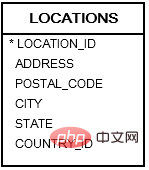
The following statement retrieves data with multiple NULL values from the state column:
SELECT DISTINCT state FROM locations ORDER BY state NULLS FIRST;
Execute the above example code and get the following results:
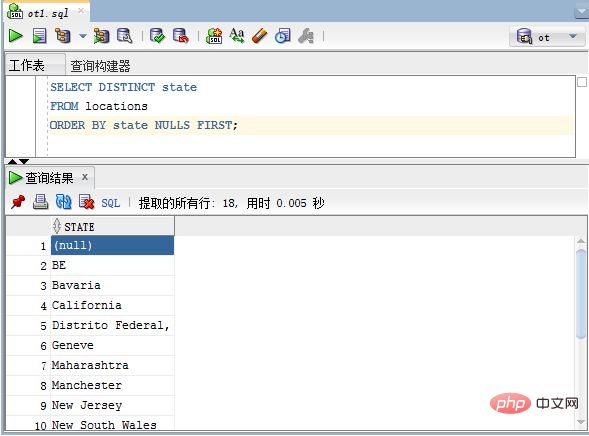
As you can see in the picture above, only a NULL value is returned.
The above is the detailed content of What is the usage of distinct in oracle?. For more information, please follow other related articles on the PHP Chinese website!

Hot AI Tools

Undresser.AI Undress
AI-powered app for creating realistic nude photos

AI Clothes Remover
Online AI tool for removing clothes from photos.

Undress AI Tool
Undress images for free

Clothoff.io
AI clothes remover

Video Face Swap
Swap faces in any video effortlessly with our completely free AI face swap tool!

Hot Article

Hot Tools

Notepad++7.3.1
Easy-to-use and free code editor

SublimeText3 Chinese version
Chinese version, very easy to use

Zend Studio 13.0.1
Powerful PHP integrated development environment

Dreamweaver CS6
Visual web development tools

SublimeText3 Mac version
God-level code editing software (SublimeText3)

Hot Topics
 What to do if the oracle can't be opened
Apr 11, 2025 pm 10:06 PM
What to do if the oracle can't be opened
Apr 11, 2025 pm 10:06 PM
Solutions to Oracle cannot be opened include: 1. Start the database service; 2. Start the listener; 3. Check port conflicts; 4. Set environment variables correctly; 5. Make sure the firewall or antivirus software does not block the connection; 6. Check whether the server is closed; 7. Use RMAN to recover corrupt files; 8. Check whether the TNS service name is correct; 9. Check network connection; 10. Reinstall Oracle software.
 How to solve the problem of closing oracle cursor
Apr 11, 2025 pm 10:18 PM
How to solve the problem of closing oracle cursor
Apr 11, 2025 pm 10:18 PM
The method to solve the Oracle cursor closure problem includes: explicitly closing the cursor using the CLOSE statement. Declare the cursor in the FOR UPDATE clause so that it automatically closes after the scope is ended. Declare the cursor in the USING clause so that it automatically closes when the associated PL/SQL variable is closed. Use exception handling to ensure that the cursor is closed in any exception situation. Use the connection pool to automatically close the cursor. Disable automatic submission and delay cursor closing.
 How to delete all data from oracle
Apr 11, 2025 pm 08:36 PM
How to delete all data from oracle
Apr 11, 2025 pm 08:36 PM
Deleting all data in Oracle requires the following steps: 1. Establish a connection; 2. Disable foreign key constraints; 3. Delete table data; 4. Submit transactions; 5. Enable foreign key constraints (optional). Be sure to back up the database before execution to prevent data loss.
 How to paginate oracle database
Apr 11, 2025 pm 08:42 PM
How to paginate oracle database
Apr 11, 2025 pm 08:42 PM
Oracle database paging uses ROWNUM pseudo-columns or FETCH statements to implement: ROWNUM pseudo-columns are used to filter results by row numbers and are suitable for complex queries. The FETCH statement is used to get the specified number of first rows and is suitable for simple queries.
 How to create cursors in oracle loop
Apr 12, 2025 am 06:18 AM
How to create cursors in oracle loop
Apr 12, 2025 am 06:18 AM
In Oracle, the FOR LOOP loop can create cursors dynamically. The steps are: 1. Define the cursor type; 2. Create the loop; 3. Create the cursor dynamically; 4. Execute the cursor; 5. Close the cursor. Example: A cursor can be created cycle-by-circuit to display the names and salaries of the top 10 employees.
 How to stop oracle database
Apr 12, 2025 am 06:12 AM
How to stop oracle database
Apr 12, 2025 am 06:12 AM
To stop an Oracle database, perform the following steps: 1. Connect to the database; 2. Shutdown immediately; 3. Shutdown abort completely.
 How to create oracle dynamic sql
Apr 12, 2025 am 06:06 AM
How to create oracle dynamic sql
Apr 12, 2025 am 06:06 AM
SQL statements can be created and executed based on runtime input by using Oracle's dynamic SQL. The steps include: preparing an empty string variable to store dynamically generated SQL statements. Use the EXECUTE IMMEDIATE or PREPARE statement to compile and execute dynamic SQL statements. Use bind variable to pass user input or other dynamic values to dynamic SQL. Use EXECUTE IMMEDIATE or EXECUTE to execute dynamic SQL statements.
 What steps are required to configure CentOS in HDFS
Apr 14, 2025 pm 06:42 PM
What steps are required to configure CentOS in HDFS
Apr 14, 2025 pm 06:42 PM
Building a Hadoop Distributed File System (HDFS) on a CentOS system requires multiple steps. This article provides a brief configuration guide. 1. Prepare to install JDK in the early stage: Install JavaDevelopmentKit (JDK) on all nodes, and the version must be compatible with Hadoop. The installation package can be downloaded from the Oracle official website. Environment variable configuration: Edit /etc/profile file, set Java and Hadoop environment variables, so that the system can find the installation path of JDK and Hadoop. 2. Security configuration: SSH password-free login to generate SSH key: Use the ssh-keygen command on each node





